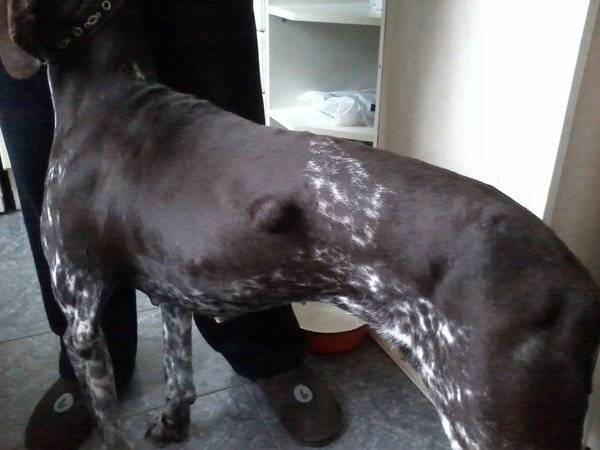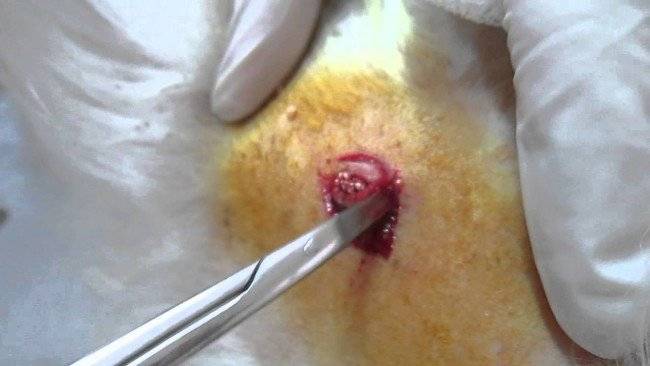Fat in dogs, it is also called a lipoma, enough common occurrence. Many owners find pets on the body tumor formations and panic. After all, for most In humans, a tumor is associated with cancer. but in this case, there is no question of any cancer. What to do if the pet has a lipoma?

Photo of a wen in a dog
Content
- 1. Causes of the appearance of wen in dogs
- 2. Complications caused by lipoma
- 3. Who is at risk
- 4. Features of wen
- 5. How to recognize a lipoma
- 6. Diagnosis of the disease
- 7. Methods of treating wen
Causes of the appearance of wen in dogs
Contents
First of all, it is worth considering what a lipoma is. it benign formation, which consists of adipose tissue. The study of this ailment did not give an exact answer, what is the exact cause of wen in dogs. Among the many existing hypotheses distinguish the following:
- genetic predisposition;
- direct inheritance of the disease;
- adverse environmental conditions;
- slagging of the animal organism;
- impaired renal and hepatic activity.
Lipoma formation occurs due to blockage of the sebaceous glands. or because of the localized growth of adipose tissues, therefore their the appearance is associated with a violation of metabolic processes in the body, which leads to a deficiency of the protein enzyme.
Lipoma Complications
In most cases, wen on the body of the pet is quite harmless, but there are exceptions. Despite the seeming harmlessness lipom, certain risks do exist. Cases recorded degeneration of wen into a malignant tumor – fibrosarcoma. This can occur in dogs at risk for cancer. diseases. But initially malignant fat cells (liposarcoma disease) is extremely rarely diagnosed.
In addition, adipose in dogs can grow very much, obstructing the movement of the animal. Often, their increase leads to the fact that large fat formations begin to put pressure on the internal organs. Zhiroviki, in certain situations, can be very painful.
Growing and becoming larger, the wen increases so much that it is in a hanging position. Such a situation threatens with impaired blood flow in the lipoma itself and the death of its upper parts. And this is an open way to enter the body animal pathogens.
Large as well as drooping wen can hurt the dog, as they exert pressure not only on nearby tissues, but also nerve roots are often squeezed.
Dangerous are wen with dark pigment, it a sure sign that the formation absorbs ultraviolet radiation. Yes, and aesthetics such education does not add. In any case, the appearance of a wen is compelling an occasion to visit the veterinarian.
Who is at risk
Most often, a benign adipose tissue observed in the following groups of animals:
- middle-aged and elderly dogs (read to which dogs grow up age);
- more often in females (50% of cases) than in males;
- obese pets.
I must say that a similar form of lipoma occurs quite often. Infiltrative lipoma (liposarcoma) is a very rare occurrence, in both dogs and cats. Among the recorded cases, that most often this malignancy is diagnosed in dogs breed Labrador.

Features of wen
Lipomas can form in almost any area of the body, having fatty tissue. The most frequent places of their formation are the subcutaneous layers of fiber on the sternum, peritoneum and upper parts of the paws. More rare are adipose that appeared on surfaces of internal organs – on the liver, stomach, intestines, lungs, etc. Naturally, this form of the disease requires diagnosis in conditions of the clinic, as you won’t recognize it in the usual way.
Lipoma can form one or form multiple accumulation of tumors, this disease is called lipomatosis. Sometimes with the appearance of wen, symmetry can be observed their location.
Diffuse formations, which are localized in the intermuscular space of the limbs. Most often they are multiple clusters of nodes, which does not allow treat them effectively.
How to recognize a lipoma
This can be done by examining the education and feeling. Usually lipoma similar to skin swelling, smooth, oval. Meet and hard wen, but in most cases they are soft to the touch and movable. Palpation of the formation does not cause pain in the pet or discomfort if the education is not too big. Grease Can long time not to grow, remaining in the same state.
Diagnosis of the disease
The description of a lipoma often allows it to be confused with other similar ones. formations, therefore, differential diagnosis is very important for identifying this entity. In the process of visiting the veterinary clinic you can find out that a lipoma on a pet’s body is not a wen at all, but abscess (this can be detected independently, as in place skin infections become very hot), hematoma (bruising), inflamed lymph node, or malignant education.
According to statistics, among all calls to veterinarians with swelling skin, in 10% of dogs they are really wen.
For diagnosis, veterinarians use the following methodologies:
- palpation (palpation of the swollen area);
- puncture biopsy fence (tissues from the deepest tumor layers);
- excision of a small part of the tumor by surgery.
The latter method is often used when the dog has a lipoma. burst. In this case, speed of data acquisition is important and required urgent surgery. Naturally, without received results confirming that it is indeed a lipoma, an operation will not be conducted.
Malignant (infiltrative) formation is detected by conducting histological (pathomorphological) studies. A similar formation is often found between muscle tissues. the upper part of the paws, as well as in the retroperitoneal space.
Infiltrative lipoma requires surgery – excision of the affected areas with subsequent radiation therapy. Doctors cannot give accurate predictions, since such tumors very often recur.
Methods for the treatment of wen
Unfortunately, against lipoma, traditional therapy is powerless, only surgery will help. Lipoma does not have tendency to metastases and after complete excision is not formed on same site. Remove the wen, or leave it as it is, only a specialist decides.

If the wen has chosen the location of subcutaneous tissue as the location, most often does not cause fears. If it does not provoke pain and inconvenience, is small, you can not send pet for surgery.
If you can’t avoid it, then you need to prepare a pet – Do not give food for a day, but do not violate the water regime. If the lipoma is dogs already burst, then the operation is done urgently.
How does this procedure go:
- Zhirovik is in the capsule and has a little blood vessels. After the surgeon dissects the layers of the skin over education, it separates the lipoma from the surrounding tissues.
- Such formations almost never bleed, but sometimes it still requires dressing the main vessel, which nourishes lipoma.
- As soon as the wen is removed, the doctor gently sutures the cavity, which was formed during the operation.
Much more complicated is the situation with intermuscular lipomas, since such a variety is rare. They grow almost imperceptibly, while being particularly aggressive. Are located these tumors in the intramuscular layers, scattering throughout in separate fragments. The lack of educational boundaries makes the operation is extremely complex. The proliferation of intermuscular lipoma accompanied by an increase in paw size, the pet begins limp and feel pain. Removing such an entity does not guarantees the absence of its reappearance.
After the operation, the dog needs care. Postoperative suture should be regularly treated. antiseptics. See that the animal does not lick, do not scratch it a place. You can use special collars in which the pet will not be able to reach the place of the cut.
In most cases, surgery ends safely and after 1.5 weeks you can visit a doctor in order to remove the seams.






